526. $50
Seth Thomas “Round Band”, 1863-1913. An enduring model from Seth Thomas, a miniature O.G. clock
just under 17 inches tall. They made them in both 8-day and 30-hour; this is a 30-hour time-and-strike. The case is a
bit crusty but the veneer is mostly intact. Both glasses are old, the lower glass with a nice reverse image of two putti’s with
only slight losses. The metal dial has been repainted, with ST hands. The lyre movement is signed and from Plymouth Hollow;
the label says Thomaston, so this clock was likely made shortly after 1865. It is running vigorously and striking on cue. $50-$125.
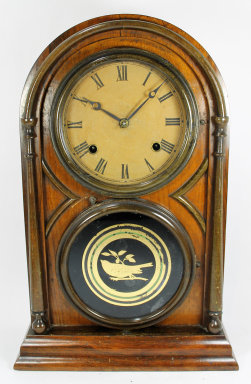
527. $50
Atkins Clock Co. “Round Top No. 1”, ca. 1873. A clean rosewood case, 18 inches tall, two old
glasses, the lower with a nice gilt bird image. There is a good label inside. The dial paper is yellowed. The 8-day
time-and-strike unsigned movement is running and striking. $50-$100.
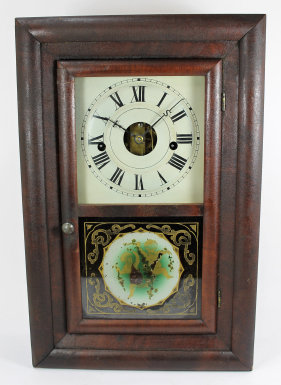
528. $150
French “Bull’s Eye”, ca. 1890. A 24-inch case with an unusual metal surround decorated with
a raised gold trim of flowers, berries, and vases. The flowers are painted and many are further decorated with “sparkle”, like
what you would use in craft projects as a kid in school. Some of the decorated flowers have lost their sparkle. There
is a gold filigree trim around the outer edge of the surround. I don’t believe I’ve seen a bull’s eye, or baker’s clock
like this before; the surround is usually wood with MOP decoration. The paper dial is new, behind a glass cover; the outer door
glass is old and wavy. The ornate hands are likely original but have been painted. The metal frame movement with a snail
strike mechanism is running, but fast, and is not striking appropriately. We do not know how to adjust it, as it will strike
when triggered by hand. The clock is running fast as well, and the pendulum bob is at its maximum extension; it may not be the
right pendulum for the clock. It could be easily adjusted by adding a short wire extender. A pretty clock that needs some
mechanical attention. $175-$250.

530. $50
Seth Thomas “Empire No. 201”, ca. 1928. This crystal regulator stands 9 5/8 inches tall with
4 beveled glasses in good shape but a dull finish. The porcelain dial shows several hairlines and the hands are not original
issue. The fittings are loose and need to be secured, including the hanging gong. We could not get it running. $50-$100.
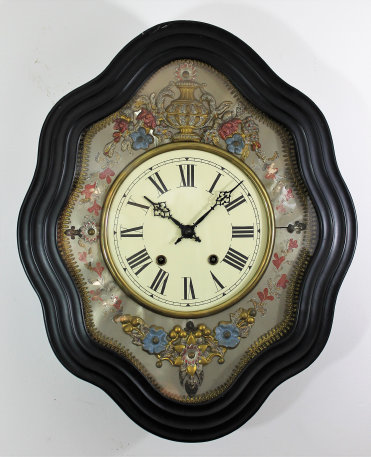
529. $75
New Haven “Wilson”, ca. 1920. This large banjo (40.5 inches tall) is a 30-day timepiece, double-wind,
no strike. It has a silvered dial in very good shape behind a convex glass in the bezel, but both tablet glasses are backed
by cardboard replicas of the original decorated glass panels. In addition, the lower door does not fit correctly and may be
a replacement; it is held in place by a hook on the side that needs to be repositioned to hold the door shut properly. The clock
is running and keeping time. In more original condition this clock would sell for $250 or more; one sold on eBay in 2016 for
$431. $75-$150.

531. $75
Ingraham “Nyanza”, ca. 1915. This 39-inch banjo is a time and strike, with the gong mounted
inside the throat. This model also came time-only. The “natural grain case with rubbed mahogany finish” is clean and the
silvered dial is in very good shape behind a convex glass. There is some lifting on the throat glass border, the lower tablet
looks fine. The finial is correct. The 8-day movement is running and keeping time, striking the hours, but the hammer
is not hitting the coiled gong and will need a slight adjustment. There is a good label on the back. This model sells
on eBay and elsewhere for $100-$150.
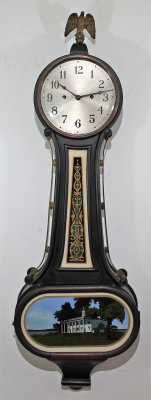
532. $1750
English triple fusee bracket clock, ca. 1872-1902. The Webster family produced clocks from
1711 until 1914 and were located on Queen Victoria St. in London in the late 1800’s. This massive carved oak cabinet is 33 inches
tall to the top of the center finial and 20 inches wide at the base. I see no damage or missing pieces other than a missing
ring in the left rear lion’s mouth, two shrinkage cracks to the oak bezel, and warping to the fretwork on both sides. The silvered
dial is in reasonable shape, with some discoloration. It is signed “Webster · Queen Victoria St · London · 17388” and is also
signed on the movement. The back door is wire screened and backed with fabric, as are the side wooden fretworks. The brass plate triple fusee movement plays Westminster Chimes on four large coiled gongs and strikes the hours on a fifth gong. It is running and striking appropriately. You’ll need a large space for this impressive clock. We couldn’t find any recent
comparable sales but based on older sales of similar clocks we would expect this clock to sell in the $2000-$3000 range.
Side view Back Movement from top
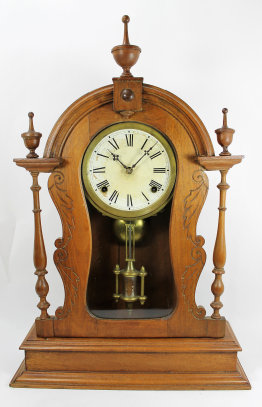
533. $125
Ansonia “Mantel Monogram”, ca. 1874. Not a common clock; there are no listings in the Antique
Clocks Price Guide. We have two in this auction, as well as a Hanging Monogram (#503) – when it rains it pours. The case
is walnut and in need of a waxing as the finish is dull. It stands 23 inches tall with the center finial, all of which look
correct or close matches, but the right finial needs some touch-up at the neck. The case design differs slightly from the catalog
illustration on page 446 of Ly’s book on Ansonia clocks – note the curved corners in the door glass frame vs the acute angle corners
in the illustration. It has been reglued in places and a bit sloppily. The pendulum also differs from the illustration. The dial paper shows some wear and is not signed; the 8-day time-and-strike movement is signed and running. The door glass is
old; there is no label, but the book says it was manufactured by Ansonia Brass and Copper Co. $125-$250.
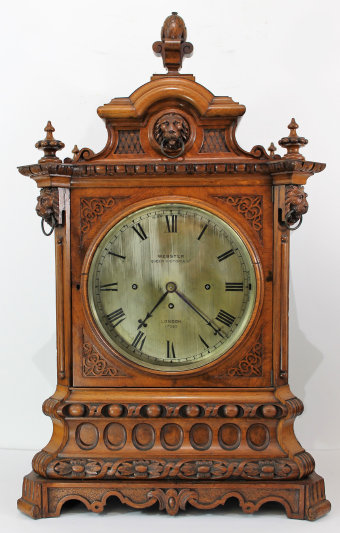
534. $125
Ansonia “Mantel Monogram”, ca. 1874. A second Monogram in this auction, also in walnut with
a better finish. Note that the door glass cutout again differs from that in the catalog illustration. The two side finials
look correct/original, the center finial is a close match replacement. The glass is old but probably replaced, the paper dial
is new. The pendulum is Ansonia issue. The 8-day, time-and-strike movement is signed but we can’t keep it running and
will need some attention if you wish to run this clock. It strikes very nicely on a nickel bell. Again, no label inside
or back.
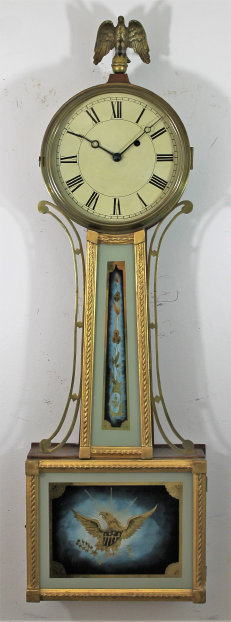
535. $500
Early weight-driven banjo. This 32-inch banjo has had some restoration, making dating difficult. The unsigned movement is a typical time-only, running 8 days on a cast iron weight. The iron dial was probably repainted some
time ago, the hands are period, and the weight shield is old. Both glasses have been repainted nicely but are unsigned. The gilt trim has also been painted gold and there may have been some wood repairs to the throat. The case itself looks very
old but may have been stripped/cleaned some time ago. The dial glass is old and is held in by silicone sealant due to loss of
the metal tabs that should hold it in place. The brass bezel is heavy, held in place by a hook closure, as is the lower door. The brass pendulum hold-down is missing the lock-nut and interferes with the pendulum, which may be a replacement as it is slightly
too long for the hold-down. The brass eagle finial suffered a break in the legs and has been repaired and is still fractured
but holding together. All that said, this time-piece looks great and is running and keeping time. $500-$800.

